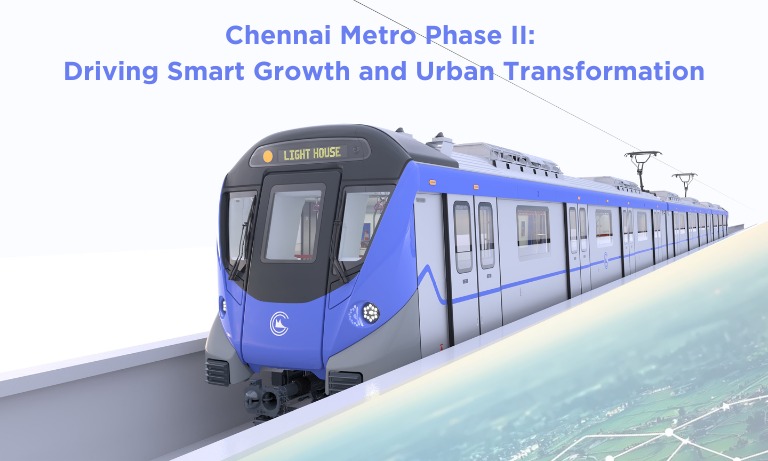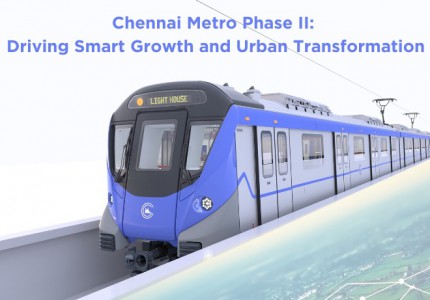Chennai Metro Phase II: Driving Smart Growth and Urban Transformation

The Chennai Metro Rail Project Phase II is set to redefine how the city moves, lives, and grows. With an expansive new network of nearly 119 kilometers and 128 stations across key zones of Chennai, this landmark infrastructure initiative is more than a transport upgrade—it’s a catalyst for real estate development, economic growth, and sustainable urban living.
Strategically designed to connect key residential, commercial, and industrial areas, Phase II positions Chennai as a future-ready metropolis. For homebuyers, investors, and businesses, it opens unprecedented opportunities along emerging corridors where convenience and connectivity will drive lifestyle and property value alike.
Unlocking Chennai’s Potential with Expanded Metro Connectivity
Phase II marks the most significant metro expansion in Chennai’s history, integrating three major corridors—Purple (Corridor 3), Orange (Corridor 4), and Red (Corridor 5)—into a single, well-connected network. Together, they will increase the city’s total metro coverage to approximately 173 kilometers, transforming the way people commute, work, and invest.
Corridor 3 (Purple Line) stretches 45.8 kilometers from Madhavaram in North Chennai to SIPCOT in the southern IT belt. With 49 stations, including those at Perambur, Nungambakkam, Adyar, and Thiruvanmiyur, this corridor serves a vital function for daily commuters and tech professionals navigating the bustling SIPCOT zone.
Corridor 4 (Orange Line), a 26.1-kilometer route from Lighthouse to Poonamallee Bypass, adds much-needed east-west transit. With 30 stations connecting vibrant hubs like T Nagar, Kodambakkam, and Porur, this line enhances access to growing residential zones and key employment districts.
Corridor 5 (Red Line) spans 47 kilometers from Madhavaram to Sholinganallur, covering industrial pockets and the dynamic IT corridor along Old Mahabalipuram Road (OMR). This 48-station stretch links areas like Villivakkam, Porur, and Medavakkam, promising seamless mobility between Chennai’s northern and southern growth engines.
Meeting Urban Needs: Mobility, Sustainability, and Liveability
Chennai is among India’s fastest-growing cities, grappling with rising vehicle density, long commute times, and fragmented public transport. Phase II directly addresses these challenges by providing an efficient, reliable, and eco-conscious transit option that reduces dependence on cars and two-wheelers.
The project’s primary objective is to shorten travel time and ease congestion on busy arterial roads like GST Road and Mount-Poonamallee Road. But its impact goes deeper—it empowers a shift toward a more sustainable and inclusive city. As metro ridership increases, carbon emissions are expected to drop, supporting cleaner air and healthier urban environments.
Moreover, improved public transport access enhances social equity. With affordable fares and inclusive design, the Chennai Metro brings modern mobility within reach for all socio-economic segments, bridging gaps between old and new urban centers.
Development Timeline and Major Milestones
Approved by the Tamil Nadu government in 2019, with a project cost estimated at ₹63,246 crore, Phase II is being developed in phases for seamless execution. Construction began in early 2020 following the finalization of the Detailed Project Report (DPR) by RITES.
Significant progress has already been made. Early 2025 saw the commencement of trial runs on Corridor 4’s 26.1-kilometer stretch from Lighthouse to Poonamallee Bypass. This section features 10 strategically located stations and state-of-the-art infrastructure, including driverless train technology tested at speeds of 80 km/h.
The complete network is scheduled for phased roll-out, with core corridors expected to open by 2026 and full project completion targeted for 2030. The rollout will be supported by multilateral funding partners, including the Japan International Cooperation Agency (JICA), which is providing concessional finance for key segments.
Smart Infrastructure for a Superior Passenger Experience
Chennai Metro Phase II is being built to global standards, combining modern design with advanced technology for a superior commuter experience. Seamless interchanges with Phase I at major nodes like Alandur, St. Thomas Mount, and Chennai Central ensure smooth transfers between lines and optimize total travel time.
The new trains, manufactured by Alstom, will be fully automated and energy-efficient, featuring regenerative braking and low-noise operation. The stations are designed with universal access in mind—equipped with elevators, tactile flooring, wide corridors, and clear signage to assist passengers of all abilities.
Ticketing will be contactless and tech-enabled, offering QR codes, stored value cards, and mobile integrations to support a cashless and convenient travel experience. Safety remains paramount, with 24/7 surveillance, fire safety protocols, and trained staff on site at all stations.
Multi-Modal Integration for Seamless Citywide Commutes
Phase II is not just a standalone upgrade—it’s part of a broader vision for integrated urban mobility. The corridors are being planned in conjunction with bus terminals, suburban rail interchanges, and feeder transport systems to ensure first-mile and last-mile connectivity.
This holistic approach enhances usability across Chennai’s transit ecosystem, encouraging more residents to make the shift to public transport. The resulting benefits—reduced road traffic, quicker point-to-point commutes, and better access to commercial and residential hubs—will ripple across the city.
Economic Growth and Real Estate Surge Along Metro Corridors
Perhaps the most profound impact of Chennai Metro Phase II will be felt in the real estate and economic sectors. As infrastructure improves, demand for property near metro stations is expected to soar. Localities like Porur, Poonamallee, Medavakkam, and Sholinganallur are emerging as real estate hotspots, driven by investor confidence and future livability.
For developers and builders, the corridors present fertile ground for transit-oriented development (TOD), where housing, retail, and commercial spaces are planned around metro infrastructure. For investors, early entry into these growth corridors could yield high long-term returns.
With increased accessibility to tech parks, hospitals, universities, and retail zones, metro-linked neighborhoods are poised for a surge in population and value. Rental yields, too, are expected to rise, making these locations attractive to both end-users and rental investors.
A New Chapter in Chennai’s Urban Future
Chennai Metro Phase II is more than a transit project—it is a transformative blueprint for a smarter, greener, and more inclusive city. It aligns with global best practices in sustainable transport, fosters regional equity, and opens new economic frontiers.
As segments begin operations in 2026, residents will benefit from faster, safer, and more comfortable commutes. Businesses will gain better access to talent and markets. And real estate along the metro routes will become a magnet for growth and innovation.
For those looking to invest, relocate, or expand within Chennai, now is the moment to explore the opportunities that Phase II is creating. Whether you're a developer, property buyer, or entrepreneur, the metro’s expansion is a signal: Chennai is rising, and it’s rising on rails.
#ChennaiMetroPhase2
#ChennaiMetroexpansion
#ChennaiMetronewlines
#Chennaipublictransport
#ChennaiMetroprojectupdate
